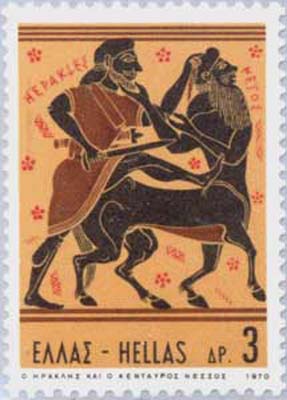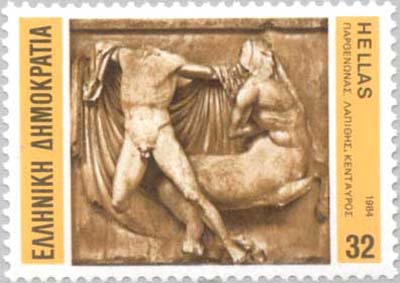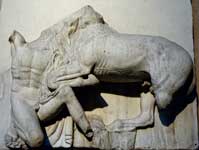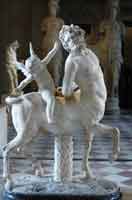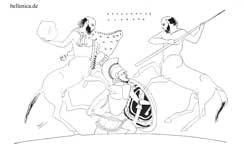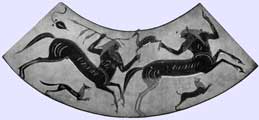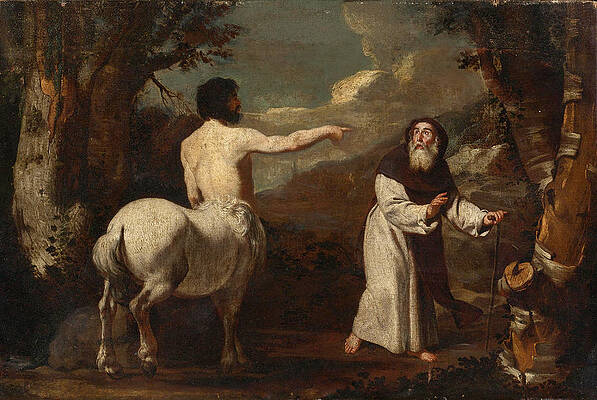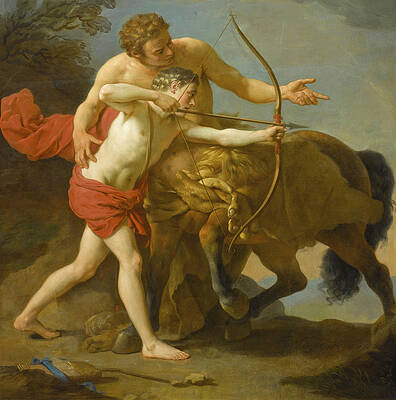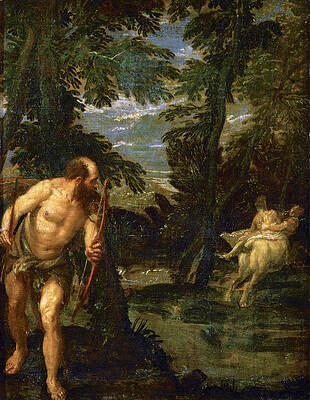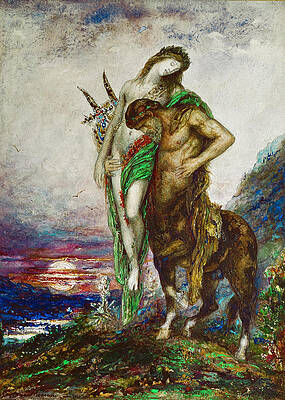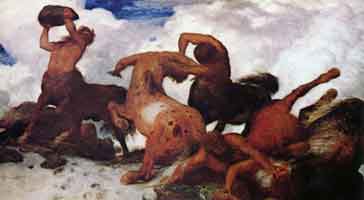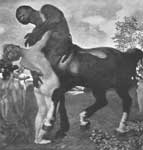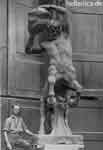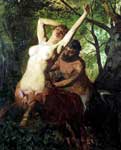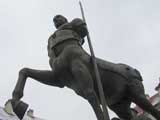.
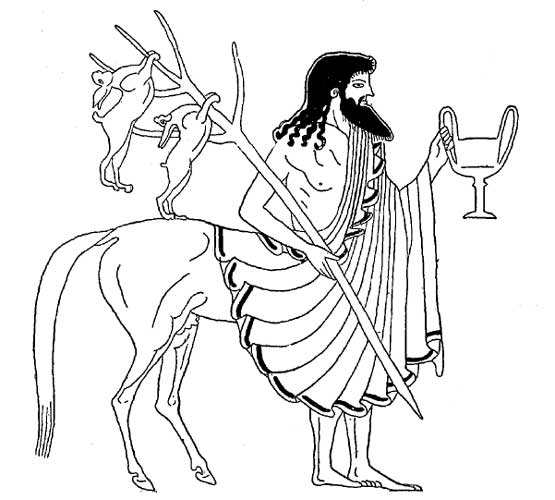
Centaur from a vase painting, (version with human legs)
In Greek mythology, the centaurs (Centaur, Greek: Κένταυρος) are a race part human and part horse, with a horse's body and a human head and torso.

Dwelling in the mountains of Thessaly, the centaurs were the offspring of Ixion and Nephele, the rain-cloud. Alternatively, the centaurs were the offspring of Kentauros (the son of Ixion and Nephele) and some Magnesian mares or of Apollo and Hebe. It was sometimes said that Ixion planned to have sex with Hera but Zeus prevented it by fashioning a cloud in the shape of Hera. Since Ixion is usually considered the ancestor of the centaurs, they may be referred to by poets as the Ixionidae.
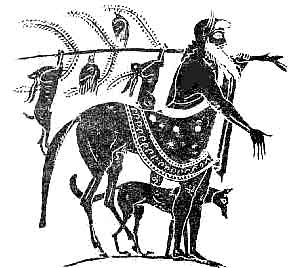
|
Hercules slaying the Centraur Nessos (or Nessus), Greece, 1970 |
|
|
|
|
The Centaurs are best known for their fight with the Lapithae, caused by their attempt to carry off Hippodamia (a "horse" woman herself) on the day of her marriage to Peirithous, king of the Lapithae, himself the son of Ixion. The strife among these cousins is a metaphor for the conflict between the lower appetites and civilized behavior in humankind. Theseus, who happened to be present, a hero and founder of cities, threw the balance in favor of the right order of things, and assisted Pirithous. The Centaurs were driven off (Plutarch, Theseus, 30; Ovid, Metamorphoses xii. 210; Diodorus Siculus. iv. 69, 70). Vignettes of the battle between Lapiths and Centaurs were sculpted in bas-relief on the frieze of the Parthenon, which was dedicated to wise Athena.
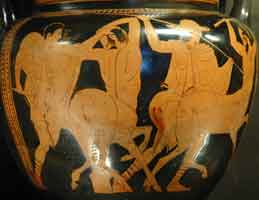
Like the Titanomachy, the defeat of the Titans by the Olympian gods, the contests with the Centaurs typify the struggle between civilization and barbarism.
The general character of centaurs is that of wild, lawless and inhospitable beings, the slaves of their animal passions. Two exceptions to this rule were Pholus and Chiron, who expressed their "good" nature, wise and kind centaurs. They are variously explained by a fancied resemblance to the shapes of clouds, or as spirits of the rushing mountain torrents or winds.
|
Abduction of Hippodameia, Carrier-Belleuse [Source] |
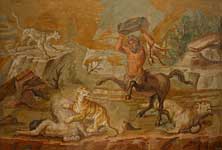
Among the centaurs, the third one with an individual identity is Nessus. The mythological episode of the centaur Nessus carrying off Deianira, the bride of Heracles, also provided Giambologna (1529-1608), a Flemish sculptor whose career was spent in Italy, splendid opportunities to devise compositions with two forms in violent interaction. He made several versions of Nessus carrying off Deianira, represented by examples in the Louvre, the Grunes Gewolbe, Dresden, the Frick Collection, New York and the Huntington Library, San Marino, California. His followers, like Adriaen de Vries and Pietro Tacca, continued to make countless repetitions of the subject. When Albert-Ernest Carrier-Belleuse tackled the same play of forms in the 19th century, (illustration above) he titled it Abduction of Hippodameia .
In early Attic vase-paintings centaurs were represented as human beings in front, with the body and hind legs of a horse attached to the back; later, they were men only as far as the waist. The battle with the Lapithae, and the adventure of Heracles with Pholus (Apollodorus, ii. 5; Diod. Sic. iv. li) are favourite subjects of Greek art (see Sidney Colvin, Journal of Hellenic Studies, i. 1881, and the exhaustive article in Roscher's Lexikon der Mythologie).
Many centaur legends state that they are very fickle creatures, and often look to the sky to determine the fates. They are great astrologers and have a love for divination.
Theories of origin
The armchair anthropologist and writer Robert Graves speculated that the Centaurs of Greek myth were a dimly-remembered, pre-Hellenic fraternal earth cult who had the horse as a totem. A similar theory was incorporated into Mary Renault's The Bull from the Sea.
Other sources speculate that the idea of centaurs came from the first reaction of a non-riding culture, as in the Minoan Aegean world, to nomads who were mounted on horses. The theory goes that such riders would appear as half-man, half-animal. Horse taming and horseback culture evolved first in the southern steppe grasslands of Central Asia, perhaps approximately in modern Kazakhstan.
Centaurs in modern fiction
The Centaur from Volos, at the University of Tennessee Hodges Library.Centaurs have appeared many times and in many places in modern times, in for example Fantasia, the Narnia books, and Harry Potter. There is also a Digimon named Centarumon.
Though the Greek word kentauros is said to be composed of a single morpheme— perhaps not a Greek one in its origin—, a suffix -taur has been invented by writers and game designers in the late 20th century for other fantasy animal-human hybrids. For more information, see the article Taur.
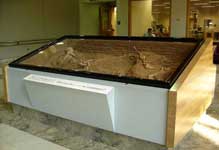
The Centaur from Volos, at the University of Tennessee Hodges Library.
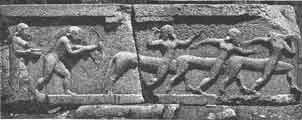
Centauromachy, Relief from Assus
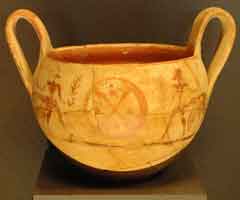
Cantharus Stathatou Louvre CA1987
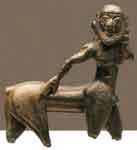


Centaur and a man, archaic sculpture
Known Centaurs
Asbolus
Bienor
Chiron, the teacher of many Greek Heroes
Chariklo
Cyllarus
Elatus
Eurytion
Hylonome
Nessus, responsible for the death of Heracles
Okyrhoe
Pelion
Pholus
Thereus
Triton
Some less known Centaurs:
Abas, Agrius, Amphion, Amydas, Amycus, Anchius, Antimachus, Aphareus, Aphidas, Arctus, Areus, Argeus, Astylus, Bravenor, Bretus, Bromus, Chromis, Chtonius, Clanis, Crenaeus, Criton, Daphnis, Demoleon, Diktys, Dorpus, Dortlas, Dryalus, Dupo, Dynaeus, Emmachius, Enopion, Erygdupus, Eurynomus, Eurytus, Gryneus, Gryphaeus, Harmandio, Harpagus, Helimus, Helops, Hippasos, Hippe, Hippotion, Hylaeus, Imbreus, Iphinous, Isopleus, Latreus, Lykabas, Lycetus, Lycidas, Lykothas, Lykus, Medon, Melanchaetas, Melaneus, Mermerus, Mimas, Monychus, Nykton, Odites, Oeklus, Oreus, Orneus, Paeantor, Perimedes, Petraeus, Phaekomes, Phlegraeus, Phryxus, Pisenor, Polenor, Praxion, Pyrakmon, Pyretus, Ripheus, Rhoecus, Rhoetus, Stiphelus, Teleboas, Thaumas, Theramon, Theroktonus, Thonius, Thurius,
Other hybrid creatures appear in Greek mythology, always with some liminal connection that links Hellenic culture with archaic or non-Hellenic cultures:
Minotaur
Mermaids
Satyrs
Sphinx
Typhon
Sculptures
Rodin - The Centaur Woman (Paris, Musée Rodin, 1887)
Images




Centauromachy West Frieze Hephaestus Temple (Thisio) Athens


Parts of the West Frieze, Centaurs and Lapiths, Bassae Apollo Temple
Image of Pholus or Pholos Athenian red-figure vase, ca. 500-450 BC. Basel. Antikenmuseum und Sammlung Ludwig BS 489.
The Centaur (1928), Alexander Yevgenievich Yakovlev (1887-1938)
Battle of the Centaurs (Michelangelo)
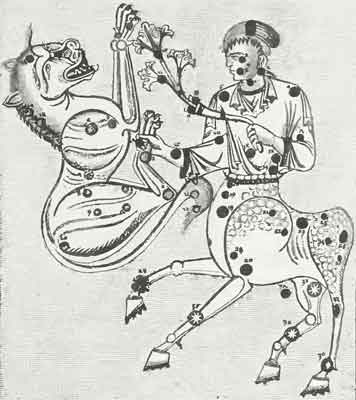
The centaur, after a miniature of the 14th century, "Liber der Locis Stellarum Fixarum.", Spanish Manuscript, Arsenal Library Paris, Centaurus Constellation
The Battle of the Centaurs, Domenico Tojetti
The Fight between the Lapiths and the Centaurs, Piero di Cosimo
Saint Anthony Abbot and the Centaur, Francesco Guarino
The Centaur Chiron instructing Achilles, Louis-Jean-Francois Lagrenee
Hercules Deianira and the Centaur Nessus, Paolo Veronese
Dead poet borne by centaur, Gustave Moreau
Theseus vanquishing the Centaur, Pietro Bettelini
|
Kentaurenkampf, Battle of the Centaurs, Arnold Boecklin, 1873 |
|
|
Sources
- Apollodorus, Bibliotheke (II, 5, 4), Epitome (I, 20)
- Diodorus Siculus, Bibliotheke (IV, 12, 3 ; IV, 12, 6-8 ; IV, 69, 5 ; IV, 70, 1)
- Homer , Iliad (I, 268 ; II, 743 ; XI, 832), Odyssey (XXI, 295 )
- Hygin, Fabulae (XXXIII)
- Ovid, Metamorphoses (IX, 123 ; XII, 210 )
- Pindar, Odes (Pythians, II, 20)
- Virgil, Aeneid (VIII, 293).
Links
- John W. Philpus, "A Catalogue of Centaurs on Greek and Related Painted Pottery", 2000 (http://members.aol.com/JWFvases/page2/index.htm)
- Did centaurs actually exist? - Article from Pravda.ru in English
- Ancient Greek Fashion for Centaurs
The Greek Myths: The Complete And Definitive Edition, Robert Graves
See also : Greek Mythology. Paintings, Drawings
| Ancient Greece
Science, Technology , Medicine , Warfare, , Biographies , Life , Cities/Places/Maps , Arts , Literature , Philosophy ,Olympics, Mythology , History , Images Medieval Greece / Byzantine Empire Science, Technology, Arts, , Warfare , Literature, Biographies, Icons, History Modern Greece Cities, Islands, Regions, Fauna/Flora ,Biographies , History , Warfare, Science/Technology, Literature, Music , Arts , Film/Actors , Sport , Fashion --- |
Retrieved from "http://en.wikipedia.org"
All text is available under the terms of the GNU Free Documentation License

